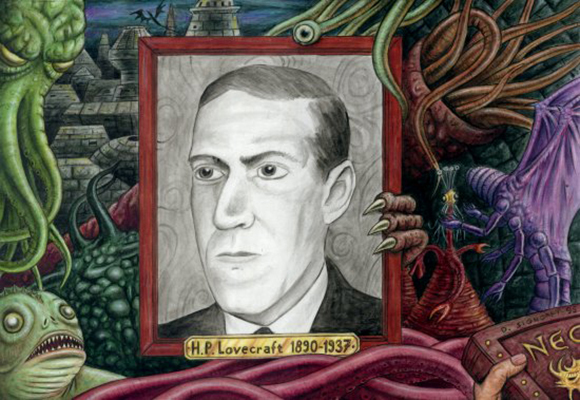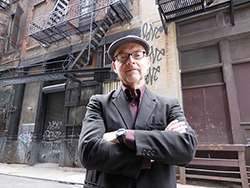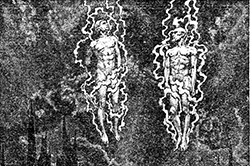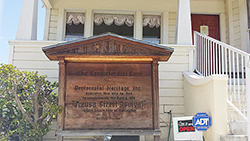What do pulp fiction and Pentecostalism have in common?

LAWRENCE — What do the speaking-in-tongues brand of Pentecostal Christianity, the weird pulp fiction of H.P. Lovecraft and the Social Gospel movement of theologian Walter Rauschenbusch have in common?
 They represent different, albeit linked, forms of semiperipheral modernism. So goes the argument by Philip Barnard, University of Kansas professor emeritus of English, and his co-author, Stephen Shapiro, University of Warwick (U.K.) professor of American literature, in their new book, “Pentecostal Modernism: Lovecraft, Los Angeles and World-Systems Culture” (Bloomsbury Academic, 2017).
They represent different, albeit linked, forms of semiperipheral modernism. So goes the argument by Philip Barnard, University of Kansas professor emeritus of English, and his co-author, Stephen Shapiro, University of Warwick (U.K.) professor of American literature, in their new book, “Pentecostal Modernism: Lovecraft, Los Angeles and World-Systems Culture” (Bloomsbury Academic, 2017).
“We now live in a global culture, and we argue that world-systems theory offers a powerful, persuasive way to look at cultural history,” Barnard said.
Barnard said that he and Shapiro challenge the notion that “elite cultural production” is the only valuable form of modernism. High-style art of the sort practiced by Joyce, Faulkner, Picasso, Woolf and Stravinsky, and emerging in world capitals such as New York, London, Paris and Berlin were not the only basis for modernism.
“We say, ‘Certainly those forms are important, but, using world-systems theory, popular culture or nonelite practices emerging in semiperipheral regions of the world economy can also be understood as part of modernism,’” Barnard said. “We need to expand our understanding of modernism. With new industries including telecommunications and new forms of travel, new practices and forms emerge in semiperipheral areas like 1906 Los Angeles.”
 Topeka was one such place, and Barnard and Shapiro trace the forerunner of the Pentecostal movement, Charles Fox Parham, there. On New Year’s Day 1901, they write, Parham laid hands on a parishioner, and she experienced the phenomenon known as “speaking on tongues … believ(ing) herself to be speaking and writing in Chinese continuously for three days,” despite having no prior knowledge of the language. Two days later, “Parham himself experienced tongues, along with several others.”
Topeka was one such place, and Barnard and Shapiro trace the forerunner of the Pentecostal movement, Charles Fox Parham, there. On New Year’s Day 1901, they write, Parham laid hands on a parishioner, and she experienced the phenomenon known as “speaking on tongues … believ(ing) herself to be speaking and writing in Chinese continuously for three days,” despite having no prior knowledge of the language. Two days later, “Parham himself experienced tongues, along with several others.”
The appearance of new institutions and forms like early Pentecostalism, the authors write, “registers a key modernizing juncture.”
After leaving Topeka for Houston, Parham attracted his most famous and influential pupil, the African-American minister William Seymour, who would go on to give birth to Pentecostalism, as it came to be known, in 1906 in Los Angeles at the so-called Azusa Street Revival. The huge, interracial crowds attracted to the ecstatic worship drew mainstream media coverage, and the phenomenon began a worldwide spread that today finds Pentecostalism as the largest denominational group in worldwide Protestantism.
At roughly the same time, Howard Phillips Lovecraft was churning out eerie fiction like “The Call of Cthulhu” and “Herbert West—Reanimator” in Providence, Rhode Island. While he was only moderately successful during his lifetime, Lovecraft and his work have grown in stature and renown, particularly in the last 20 years or so.
 “Pentecostalism and pulp fiction are triangulating points on our compass of modernism,” the authors write, finding numerous commonalities. In both cases, they said, ordinary people in early 20th-century Los Angeles and a writer in Providence respond to the social and economic pressures that they experience in their regions by developing influential new cultural forms that emphasize the “human embodiment of the paranormal or preternatural ... communicated through unusual speech (Holy Spirit speaking-in-tongues), heightened emotion leading to crises of transformation ... apocalyptic premillennialism in which the restoration of a force that portends a new world order is presaged through dispensational crises disturbing the natural world, the literalism of ancient texts ...” and more.
“Pentecostalism and pulp fiction are triangulating points on our compass of modernism,” the authors write, finding numerous commonalities. In both cases, they said, ordinary people in early 20th-century Los Angeles and a writer in Providence respond to the social and economic pressures that they experience in their regions by developing influential new cultural forms that emphasize the “human embodiment of the paranormal or preternatural ... communicated through unusual speech (Holy Spirit speaking-in-tongues), heightened emotion leading to crises of transformation ... apocalyptic premillennialism in which the restoration of a force that portends a new world order is presaged through dispensational crises disturbing the natural world, the literalism of ancient texts ...” and more.
Barnard points out that while it’s easy, viewed from the 21st century, to find evidence of Lovecraft’s personal “racist anxiety” in his writings, the weird tales also seem to acknowledge “that the elite, cultural infrastructure of New England is built on the legacy of Atlantic slavery.”
The Social Gospel movement that developed at this same time in Rochester, New York, is dealt with in an afterword of the book. Rauschenbusch, the authors write, emphasized the Old Testament prophets’ demand for social justice rather than the personal transformation of the Pentecostalists.
“We could talk about this process anywhere in the world-system,” Barnard said. “These are three examples only. We are not claiming these are a priority, but that they are three significant examples; a test case or proof of concept.”
Photos, from top: H.P. Lovecraft surrounded the creatures of the myth of Cthulhu he invented, by Dominique Signoret, via WikiCommons. KU Professor Emeritus Philip Barnard, photo taken by Stephen Spera. Illustration of "Beyond the Wall of Sleep," from pulp magazine Weird Tales. Bottom right, the front of the Bonnie Brae house where William Seymour held Bible studies before the revival meetings started at Azusa Street, by Callsignpink, via WikiCommons.